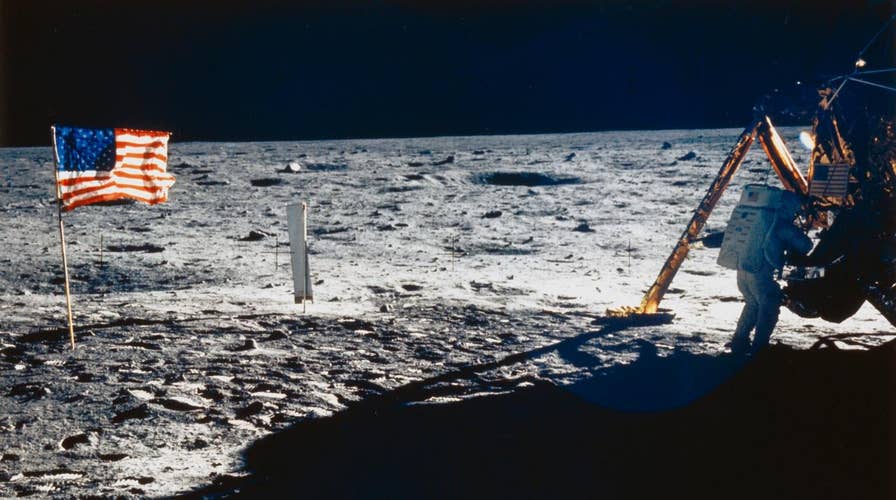Buzz Aldrin’s backup recounts Mission Control during Apollo 11
Astronaut Fred Haise, Buzz Aldrin’s backup for Apollo 11, describes Mission Control during the Moon landing.
Saturday we celebrate the 50th anniversary of the Apollo 11 moon landing on July 20, 1969, at 4:18 p.m. EDT. It is not just a moment in history – it is the greatest achievement in human history. As Neil Armstrong said when he stepped onto the moon, “One small step for man, one giant leap for mankind.”
A centuries-old dream became a reality that day. It was the culmination of a quest in space, leaving Earth and stepping on the moon. For thousands of years humans had looked up in the sky and seen the moon. Now a man actually stood on its surface.
It took three days traveling at 24,000 miles an hour for Apollo 11 to get to the moon. The astronauts orbited some 70 miles above the surface of the moon for a day before Neil Armstrong and Edwin “Buzz” Aldrin detached their Lunar Module Eagle to make their descent. Michael Collins, who flew Command Module Columbia, watched as the Lunar Module flew downward.
APOLLO 11: BUZZ ALDRIN RECALLS THE MOON'S 'MAGNIFICENT DESOLATION'
The moon landing was quite a challenge. In just 12 minutes Armstrong had to bring the Lunar Module from 50,000 feet, orbiting at several thousand miles per hour, to the moon’s surface.
They astronauts overshot the landing spot by four miles so Armstrong had to hover at 9 feet per second just over the surface, looking for a suitable landing spot. But he was able to land so softly that neither astronaut felt the impact.
Armstrong and Aldrin spent 2 hours and 36 minutes on the moon’s surface. They planted an American flag, set up experimental equipment, collected 40 pounds of moon rock and took photographs. They then had to propel from the Eagle, leaving behind one stage, to dock with the Columbia. And then fly back home. They re-entered the Earth’s atmosphere and splashed down in the Pacific Ocean on July 24 at 12:50 p.m. EDT.
One-fifth of the world’s population watched the moonwalk on television or listened on the radio. Yet, amazingly in a 1999 Gallup Poll 6 percent of Americans doubted the moon landing happened and another 5 percent were unsure. But it certainly did happen. And it changed the world.
What is most remarkable is that it was 50 years ago. Before the cell phone was invented, before there was the Internet. Martin Cooper, a Motorola engineer, made the first cellphone call in 1972. Vinton Cerf, the computer scientist who described the transmission control protocol that laid the foundation for the Internet did it in 1974.
This was the time of analog not digital, of circuit chips, not microprocessors. The amount of human intellect required to pull off such a feat is mind-boggling. Men and women using slide rules and calculators took us to the moon. They used computers but not anything we would remotely recognize today.
The Apollo Guidance Computer performed brilliantly, even though it had just 64 KB of memory and only 0.043 MHz of processing power. That was enormous at the time but nothing compared with today’s laptops that have over 320 GB of capacity. Millions of times that of the computer on which NASA staked this historic mission and the lives of three astronauts. A laptop with a 2.4 GHz processor is tens of thousands of times faster than the Apollo guidance computer.
And a computer is only as good as its software. It took 350 engineers the equivalent of 1,400 man-years to develop it before the moon landing. Part of what makes this achievement so great is the number of people who made it possible.
Besides these software engineers, there were hundreds of other engineers and scientists. It took three different teams (green, white and black) that contributed to the launch, landing and return.
The Apollo program created many items we use today. It introduced us to Velcro, freeze-dried food, memory foam and more. But most significant is the technological legacy. The silicon chip used in computers today stems from the creation of the Apollo guidance computer operating system.
Fairchild Semi-conductor – a technology startup in Palo Alto, Calif. – provided NASA with microelectronic components. Two of the scientists involved realized the future demand for miniaturized silicon chips and founded Intel. This is why that area became known as “Silicon Valley.”
Why would an inspirational author and speaker write about the Apollo 11 moon landing? I’ve had a huge interest in space since I visited Kennedy Space Center as a child. One of my life dreams is to be the first pastor in space. But it is more than that.
The greatest human achievement inspires us. It happened 50 years ago so we are due to achieve something even greater. A manned trip to Mars would do it. Considering that Mars is 140 times farther away than the moon it would be an all-time achievement. I believe that will happen in my lifetime.
CLICK HERE TO GET THE FOX NEWS APP
But what else might we achieve in the meantime? If we achieved such greatness 50 years ago then what challenges today could we overcome? If we work together we can solve our biggest problems. Health care is too costly but a necessity. We are a nation of immigrants but a sovereign country. Climate change is real but addressing it is economically onerous.
I’m confident that the country that put a man on the moon 50 years ago can meet the challenges of today. We just need that same vision, passion and commitment to make it a reality

